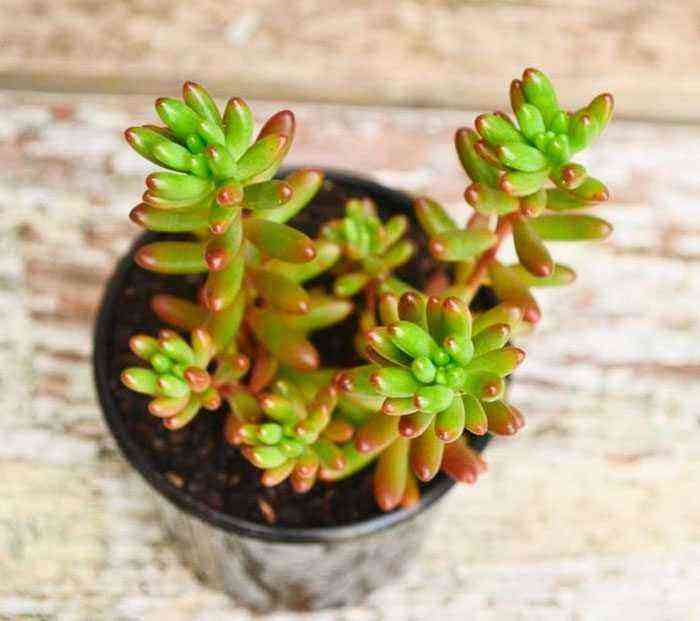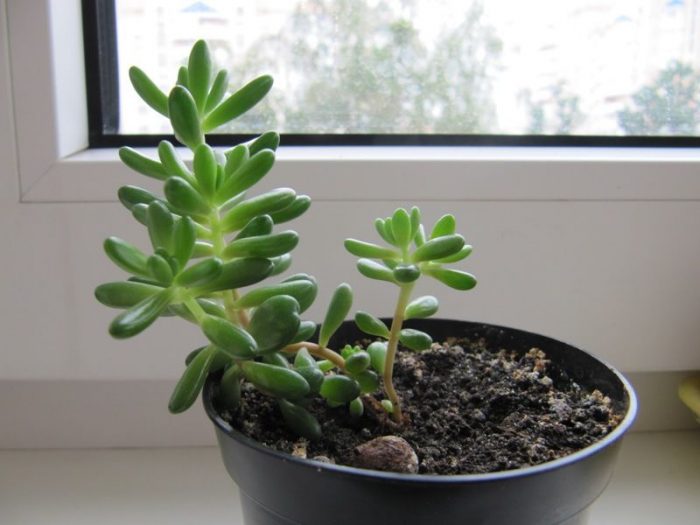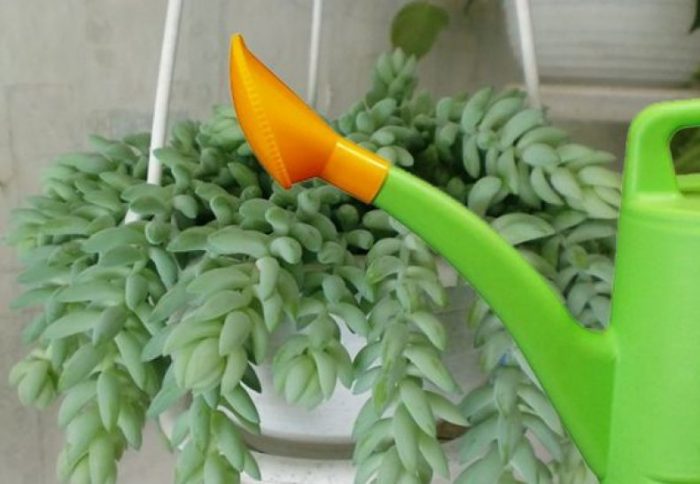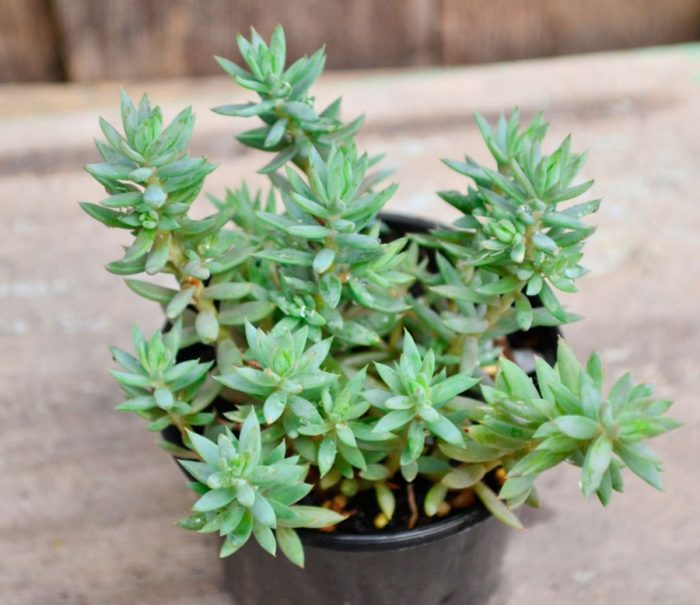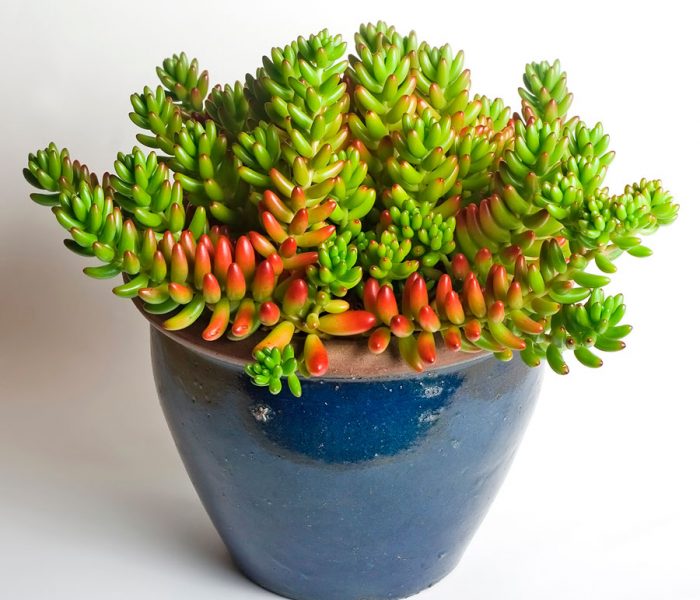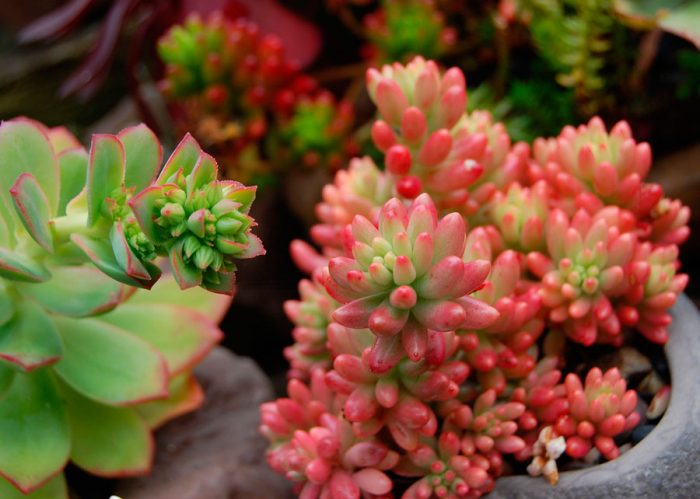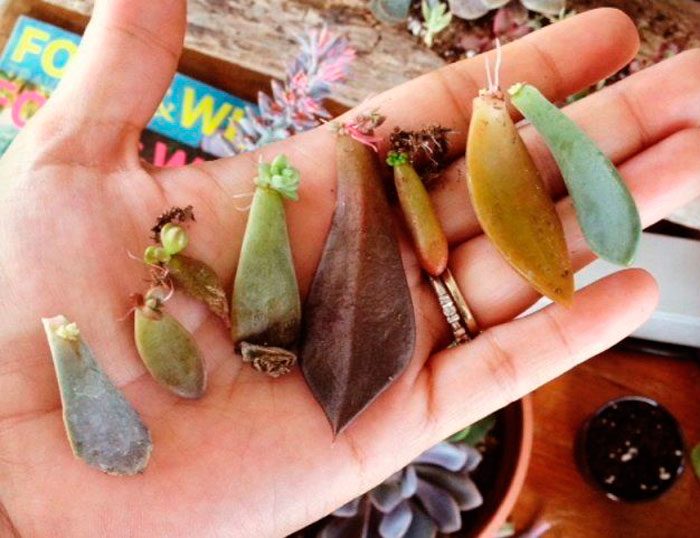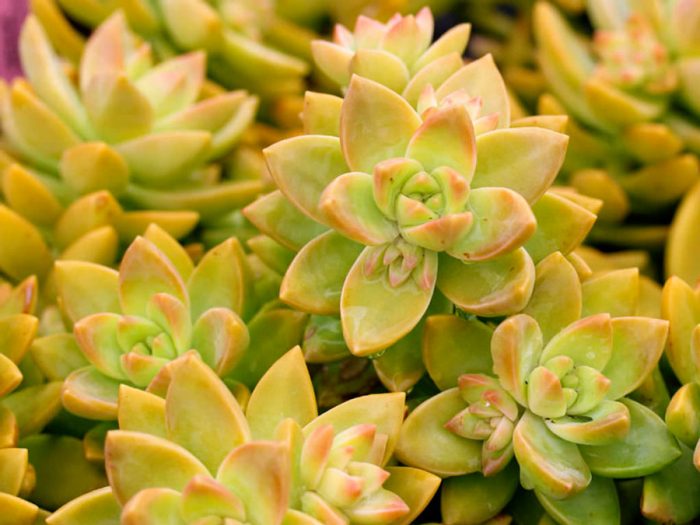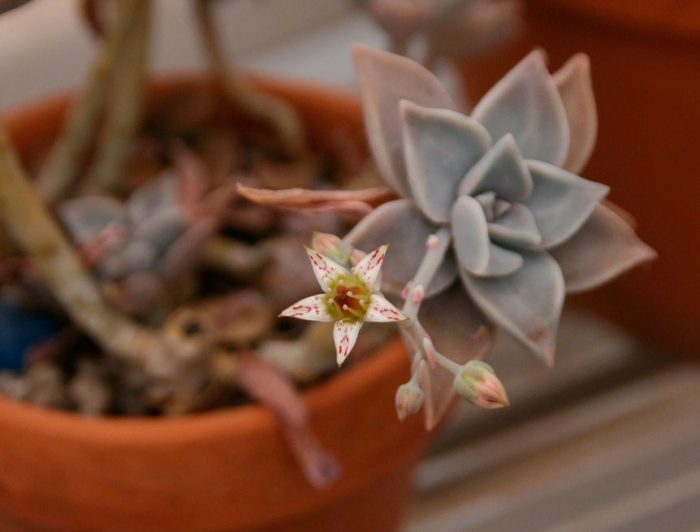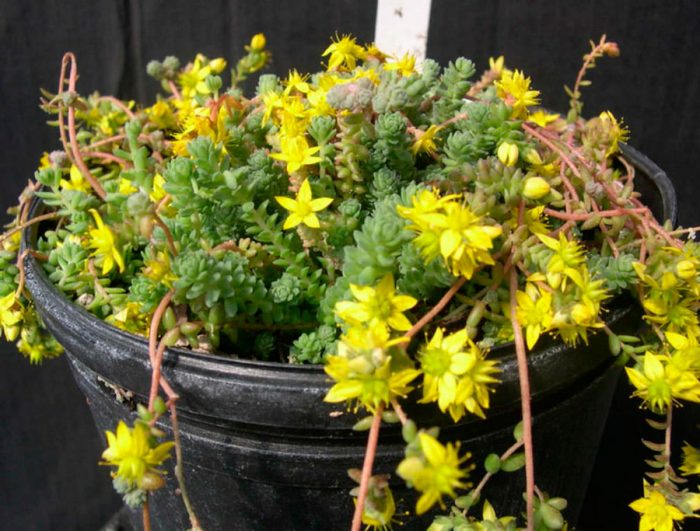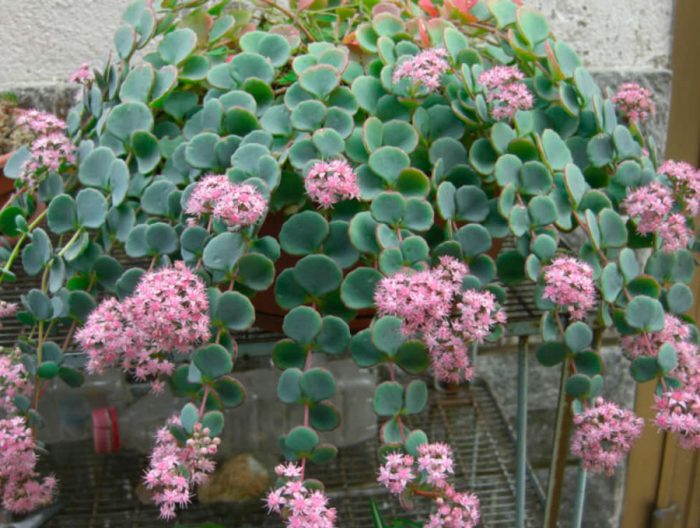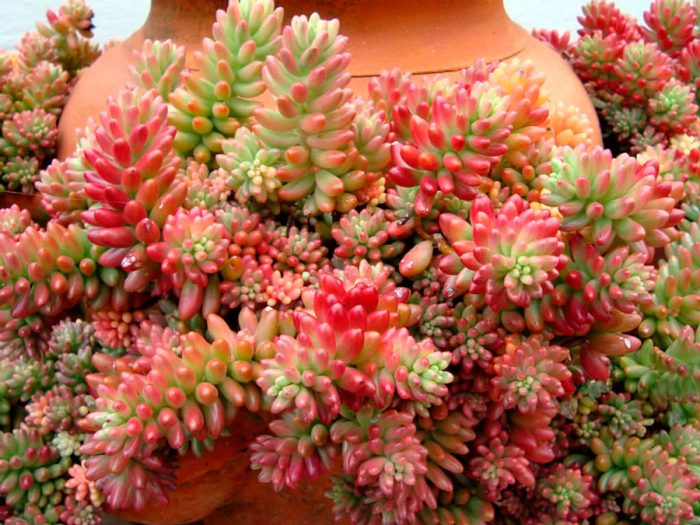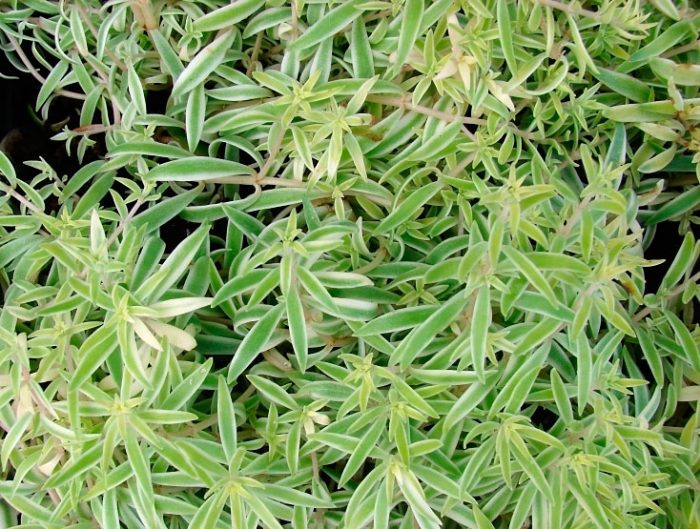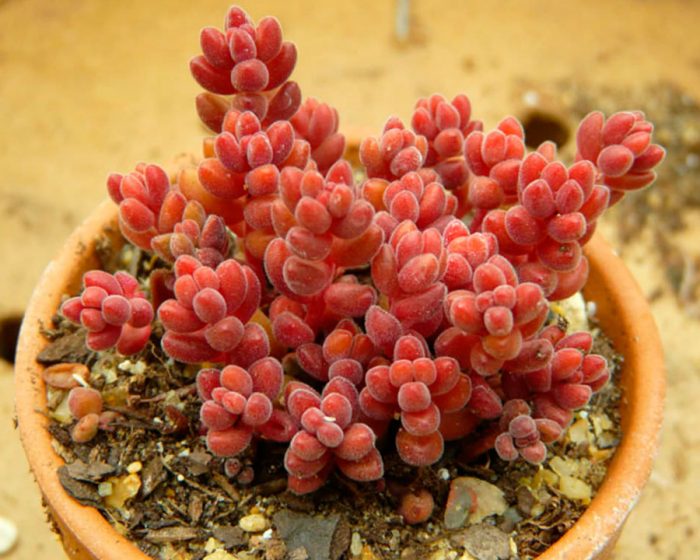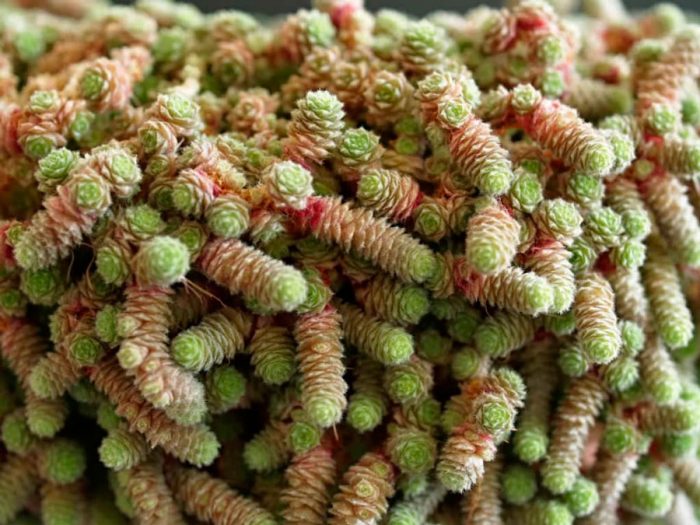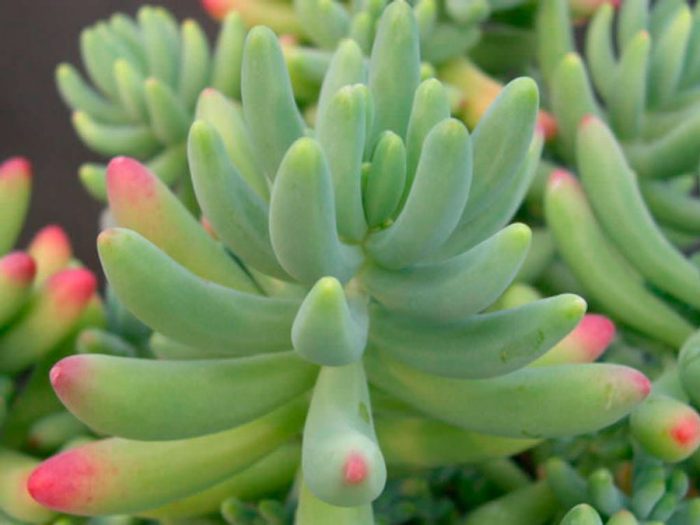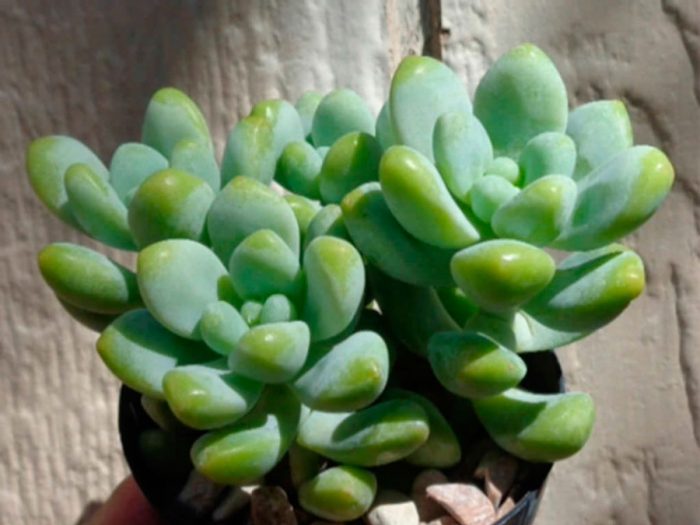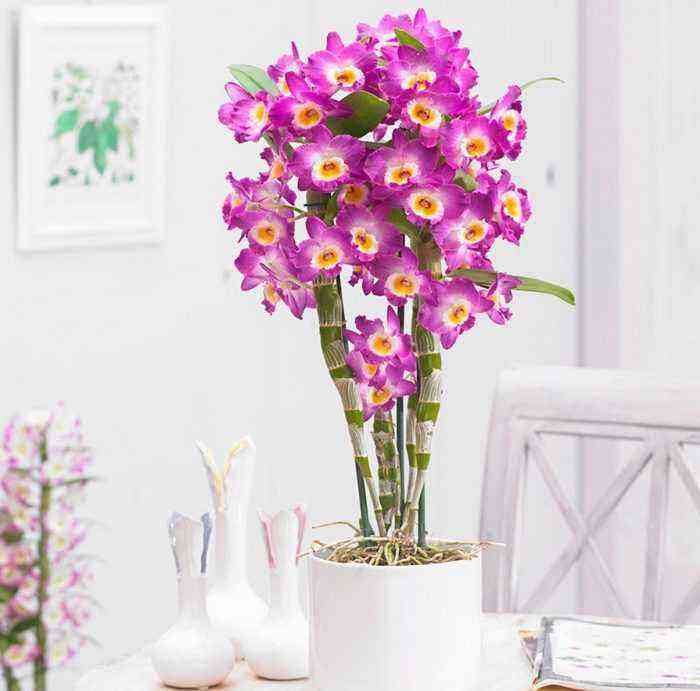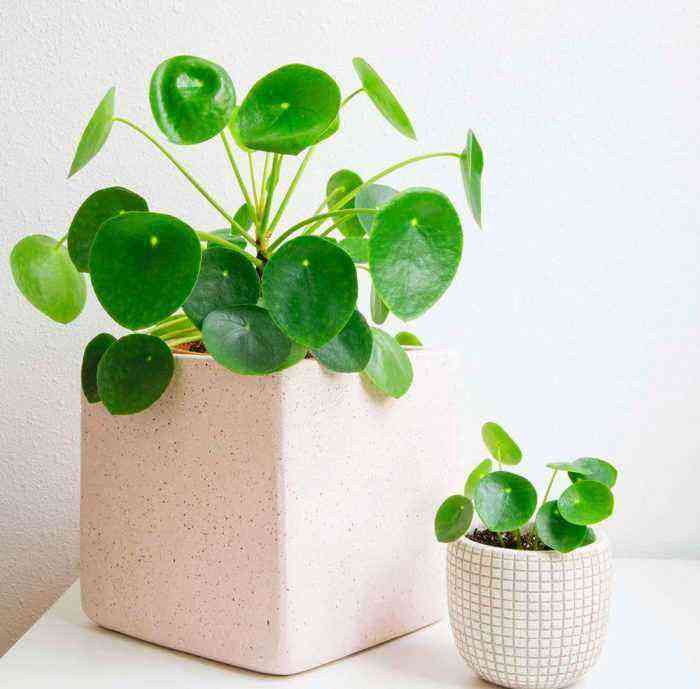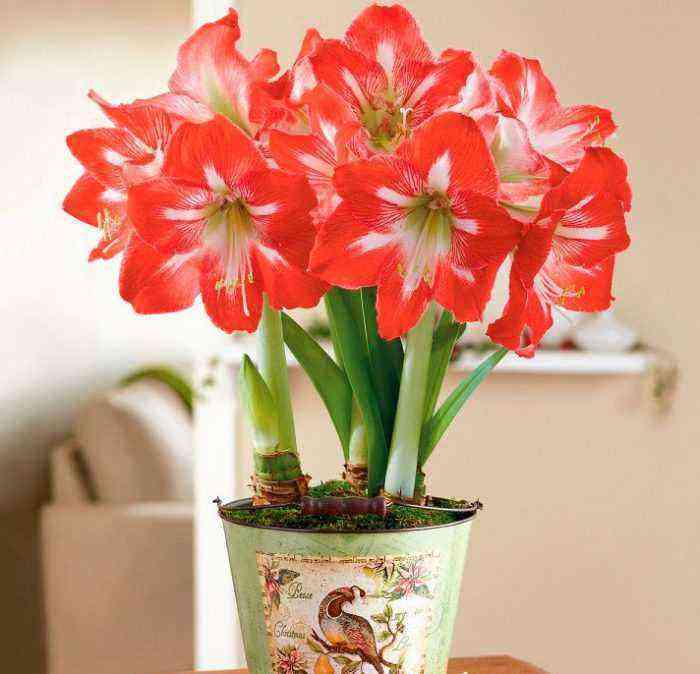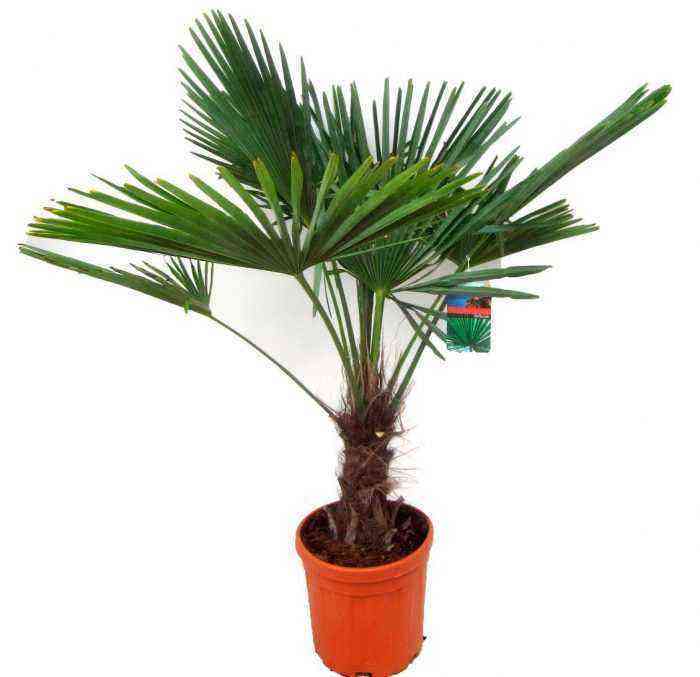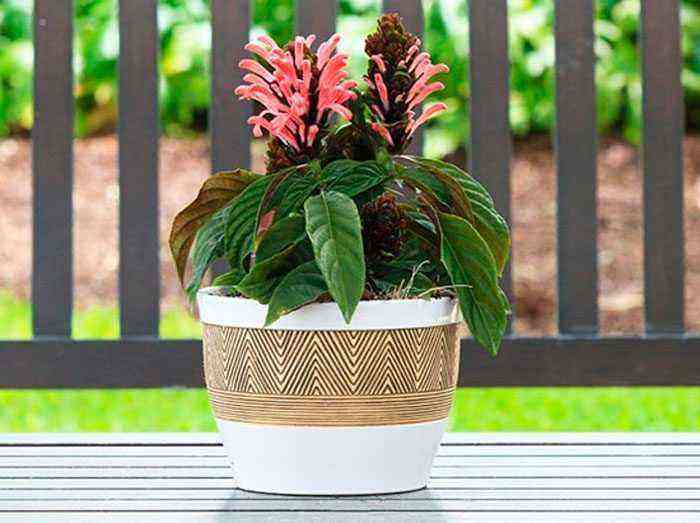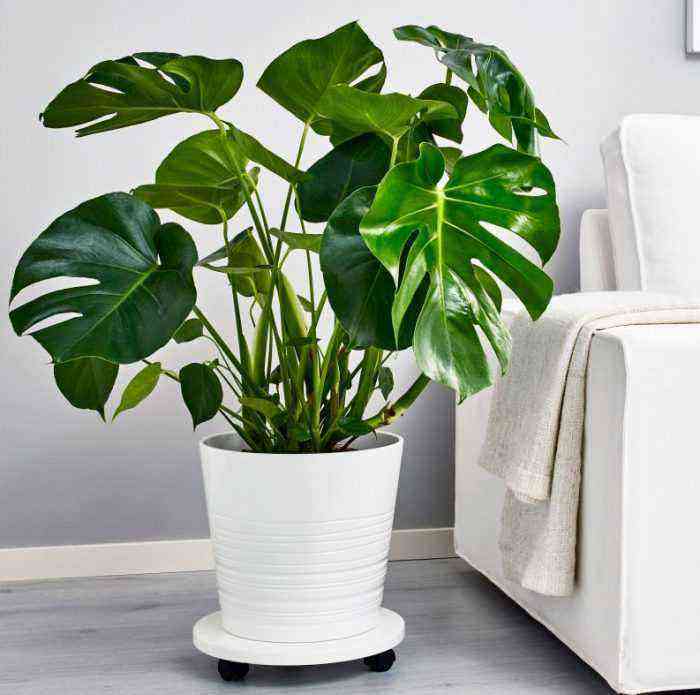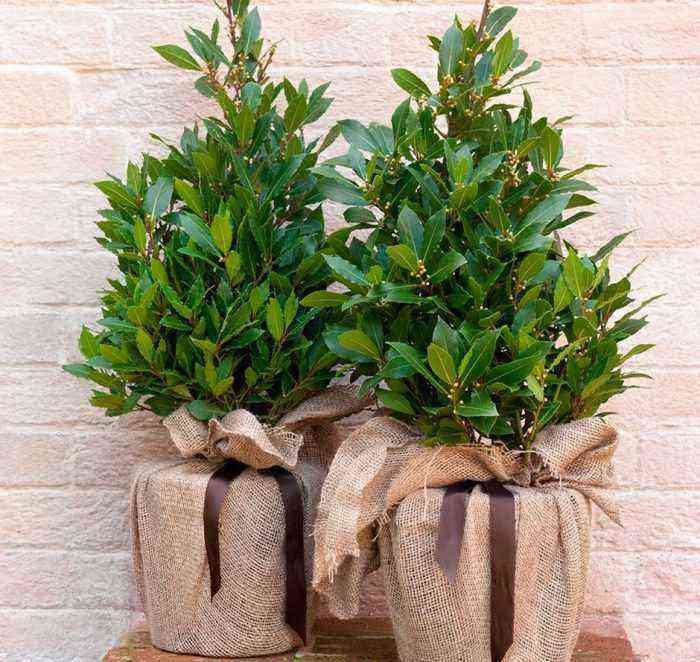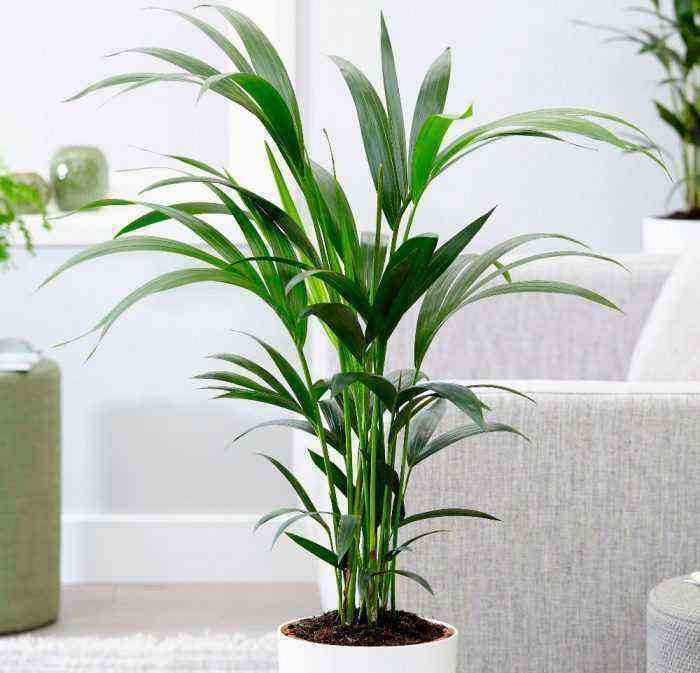The succulent plant sedum (Sedum) is a member of the Tolstyanka family. This genus unites about 600 species represented by low shrubs, succulents, as well as herbaceous plants, which can be perennials, annuals and biennials. Under natural conditions, such a plant can be found in the northern hemisphere, or rather, in the temperate zones of Europe, Asia and North America. The name of the genus was derived from the word “sit”, this is because the main feature of such a plant is that it can grow on almost all rocky surfaces. For growing at home, those types of sedum are most often chosen, which are represented by succulents, in this regard, such flowers require special care: they need to be watered moderately, occasionally fed with special fertilizers, and also provide a sufficient amount of sunlight and heat. In order for a home-grown bush to bloom, a lot of effort will be required from the grower: in winter it must be in a fairly cold place, while in summer it must provide a high air temperature. Most sedum species can be grown as ampelous plants if desired. The fact is that in natural conditions they most often grow on sheer cliffs, as well as stones, hanging from them.
Not only is such a plant very effective, but it also has healing properties. So, in alternative medicine, foliage is used for burns, and also as a wound healing agent. Sedum extract is used as a biostimulant in the same cases when the use of aloe is recommended. Such a plant is also called hernia and fever grass, as well as sedum.
Brief description of cultivation
- Flowering… Sedum is cultivated as an ornamental deciduous plant.
- Illumination… Needs the bright light of the sun.
- Temperature conditions… In the spring-summer period – from 24 to 28 degrees, and in the cold season – from 8 to 12 degrees.
- Watering… During intensive growth, water should be watered sparingly, and this is done after the soil mixture dries out in a pot half the depth. During the period from November to February, watering should be very sparse and scanty, but make sure that the earthen lump in the pot does not dry out completely.
- Air humidity… It can be anyone.
- Fertilizer… They feed the bush from early spring to autumn, do it once every 1 weeks, using a complex mineral fertilizer for cacti and succulents.
- The rest period… Around November – February.
- Transfer… Sedum can be transplanted when it is necessary regardless of the season, young bushes – once every 1 years, and adults – once every 2 or 1 years.
- Soil mixture… You can use a ready-made substrate for succulents or make a soil mixture with your own hands by combining sod and leafy soil and sand, while adding a little charcoal and fine expanded clay to it.
- Reproduction… Seed method and cuttings.
- Harmful insects… Root worms.
- disease… Decay of the root system and shoots, stretching the stems and exposing them, wrinkling of the leaf plates. All these problems are most often observed when the plant is improperly looked after.
- <font><font>Materials</font></font>… The sedum contains a poisonous substance.
Sedum care at home
Illumination
When growing sedum indoors, in order for it to grow and develop within normal limits, it will need a lot of light throughout the year. For such a culture, the direct rays of the sun are very useful, therefore, it is best to choose a sill with a southern orientation to place the bush. You can also put the flower on the east or west window, but in this case, make sure that it is not shaded by other plants or curtains. Experts do not advise choosing a north-facing window sill for sedum, since the lack of light will have an extremely negative effect on its decorative effect. The fact is that with poor lighting, its stems are strongly stretched. We must be prepared for the fact that in the winter months the bush will have to be illuminated with fluorescent lamps.
Temperature conditions
Such a home-grown plant is capable of withstanding a wide range of air temperatures. However, in order for it to develop within normal limits, it is recommended to maintain a sufficiently high temperature (from 24 to 28 degrees) in the warm season. In winter, it is recommended to put the flower on the coldest windowsill, because during these months it needs a temperature of 8 to 12 degrees. If in winter it is warm, then its stems will noticeably elongate, and this will have an extremely negative effect on its appearance. Remember to regularly ventilate the room where the sedum is located.
Watering
During the period of intensive growth, such a flower needs moderate watering, but it should be carried out systematically, since the substrate in the pot should not dry out more than half the depth. With the onset of September, a gradual reduction in watering will be required, while during the dormant period (from November to February) they need to be carried out very rarely, but make sure that the substrate in the pot does not completely dry out. When watering this crop, you need to remember that drought harms it much less than stagnant liquid in the substrate.
Air humidity
For sedum, the level of humidity in the room does not really matter; it can be both high and low. The surface of the leaf plates can be moistened with a sprayer or wiped with a damp sponge, this procedure is necessary only in order to remove dust from the foliage. It is not necessary to specially increase the level of humidity.
Fertilizer
It is necessary to feed the sedum from the first days of spring until the beginning of autumn. This should be done once every 1 weeks, while for this, special fertilizers for cacti are used (the required concentration can be found in the instructions). From the beginning of autumn until the last days of the dormant period, the flower does not need feeding.
Sedum transplant
Sedum needs a regular transplant. While the bush is young, it needs to be transplanted 1 time in a couple of years, while overgrown adult bushes – 1 time in 3 or 4 years. The transplant is carried out extremely carefully, since the leaf plates of the bush are very fragile, and they can be easily broken off, while the bald areas on the stem greatly spoil the appearance of the flower.
Such a culture tolerates transplants very easily, and therefore, if necessary, even a flowering bush can be transplanted. The capacity should be chosen low, since the root system of the flower is small. At its bottom it is necessary to make a good drainage layer; for this it is recommended to use expanded clay. A soil mixture for transplanting is suitable one that consists of leafy and soddy soil, and also sand (1: 1: 1), it is also recommended to add a small amount of small pieces of charcoal and brick to it. If you wish, you can buy a ready-made soil mixture intended for succulent plants.
Sedum properties
Morgan sedum plant contains toxic substances, which, once in the organs of the human gastrointestinal tract, can cause general weakness, vomiting and indigestion. Experts do not advise making an infusion from such a plant on your own.
Possible problems
- Exposure of the stem… This can happen for various reasons. Most often, this is due to poor lighting, in this case, the stems are stretched, which has an extremely negative effect on their decorative effect. It can also happen due to mechanical damage when the sheet plates break off.
- Rotting root system… This can be due to over-watering during a cold winter. In this case, reducing watering will help, or the bush can be updated with cuttings.
- Sedum leaves dry… This is due to the fact that the plant lacks moisture. Also, because of this, wrinkling of the sheet plates may be observed. Remember that the clod of earth in the pot should not dry out. If this happens, then water the flower as soon as possible, and the foliage will very soon restore its turgor.
- Sedum stalks are pulled out… This can happen due to excessively poor lighting, for example, when the flower is on a north-facing windowsill or in a shaded area. Such a plant requires very bright lighting and at the same time a certain amount of direct sunlight.
- Sedum Pests and Disease… If the flower is improperly taken care of, then rot will appear on it or root worms may settle.
Methods of reproduction
Propagation of sedum by cuttings
For propagation of home sedum, the method of cuttings is used, while cuttings can be taken from leaf and stem. It is recommended to plant cuttings for rooting immediately after cutting. Stem cuttings are planted in a loose and moderately light soil mixture, for example, you can combine sod and leafy soil with sand (4: 2: 1). For planting, use a low and wide bowl, while covering the cuttings from above is not necessary. They should give roots in about 2-3 weeks, and when another 15-20 days have passed, the plant can be planted in separate containers that need to be filled with sand, turf and leafy soil (1: 1: 1). For rooting of leafy cuttings, sand is used, and then they are planted in the same soil mixture as the stem cuttings. The room where the cuttings are located must be regularly ventilated.
Seed Reproduction
Such a flower can be grown from seeds in spring or autumn. For sowing seeds, use bowls or low boxes. In order for the seedlings to appear much faster, the crops are recommended to be removed to the greenhouse. After the plants have a second or third true leaf plate, they must be cut into low pots, which are filled with a substrate for seedlings (the composition is described above). The bush can bloom after 3 years or later, but only if you take proper care of it, and also provide it with optimal conditions for growth.
Types and varieties of sedum with photos and names
Sedum adolphii
This plant is a branched shrub. The thickness of the stem is slightly more than 10 mm, at first it is straight, but after a while it becomes curved. The shape of the leaf plates is scaphoid, they are rather fleshy (thickness is about 0,5 cm), their width is up to 15 mm, and their length is about 40 mm. Initially, their color is green (sometimes it is pale green), but after a while it becomes pink with a yellowish tinge. The front surface of the foliage is flat and even, while the back is slightly convex. Hemispherical inflorescences consist of white flowers.
Sedum weinbergii
Florists cultivate such a succulent as an ampelous plant. Reclining, slightly rising stems are fairly fleshy. On the surface of the elongated ovoid shiny leaf plates there is a coating of wax, they are sedentary and alternately located. The foliage is painted pinkish-green with a slight bluish tint. White flowers are part of corymbose inflorescences.
Gregg’s sedum (Sedum greggii), or varifolia sedum (Sedum diversifolium)
The birthplace of such a herbaceous perennial plant is Mexico. At first, annual short (no longer than 0,2 m) stems are naked and erect, but after a while they begin to branch slightly and creep. Young shoots are covered with small ovoid leaves, their length is not more than 0,5 cm, and the color is gray-green. On adult stems, the foliage is slightly longer (about 1,2 cm long), it is greenish and convex. Bushes bloom in the last winter weeks, and fades at the end of the spring. On a short peduncle, yellow flowers grow, collected in bunches of 2-4 pieces.
Sedum sieboldii
The homeland of this species is Japan. This herbaceous perennial plant is cultivated at home. The length of the hanging stems is about 0,3 m. The round sessile leaf plates have a greenish color, towards the edge the color becomes pale red. Such bushes bloom from the beginning to the middle of the autumn period. The color of the flowers is pink. When cultivated in indoor conditions, it has a fairly high endurance.
Sedum compactum
The homeland of such a herbaceous perennial plant is Mexico. In this species, tiled small gray-green leaf plates of an elongated ovoid shape are quite tightly adjacent to each other. The bush blooms in the first half of the summer period, 2 or 3 fragrant white flowers grow on the peduncle.
Sedum red-colored (Sedum rubrotinctum)
This species is a short plant. The creeping stems rise slightly after a while. Rounded dark green leaf plates have a tip that begins to turn red over time. They grow in apical rosettes. The color of the flowers is deep red.
Sedum lineare
The homeland of such a herbaceous perennial plant is China and Japan. Creeping, easily rooting stems are strongly branched. Small leaf plates are collected in whorls of 3 or 4 pieces, their front surface is flat, the color is pale green, and the shape is linear (length about 15 mm, while the width is up to 5 mm). As a rule, this species is cultivated as an ampelous plant. It blooms from the last days of spring to the beginning of the autumn period. The umbrellas are composed of yellow flowers.
Sedum morganianum
The birthplace of such a herbaceous perennial plant is Mexico. In length, the stems reach about 100 cm, they are densely covered with foliage. Volumetric greenish oval leaf plates have a straight front surface, their width is about 0,5 cm, and their length is up to 2 cm. This species is cultivated as an ampelous plant, and with proper care it can please you with lush flowering. Umbrellas consist of 10-15 pinkish-red flowers.
Sedum potosinum
This species is a perennial succulent plant. Young stems are creeping, but over time they begin to rise. In the upper part, the linear sessile alternately located leaf plates are rounded, they have a greenish color with a sheen of white and a pale pink top. In such a flower, the stems are very quickly drawn out, in this regard, they must be systematically cut off. The color of the flowers is white.
Sedum stahlii
Such a large herbaceous shrub is a perennial, and it comes from Mexico. In natural conditions, its height can reach 20 meters. The straight stem practically does not branch. Weakly branching shoots are creeping. Thick, small, ovate leaf plates opposite, with slight pubescence on their brownish-red surface. Their width is about 6–8 mm, and their length is up to 10 mm. In the upper part of the branched peduncle there are paniculate inflorescences, consisting of yellow flowers. The bush blooms in the last summer and first autumn weeks. This type is popular with flower growers.
Creeping sedum (Sedum humifusum)
This low sod plant is native to Mexico. Short hairs are located on the edge of the green ovoid leaf plates. After a while, the foliage develops a pale red tint. The bush blooms from the second half of the spring period to the first summer weeks. Single flowers are yellow in color.
Sedum thick-leaved (Sedum pachyphyllum)
The homeland of such a shrub is Mexico, their height is about 0,3 m. Dense clavate grayish-gray leaf plates in length reach 40 mm, their upper part is dull, over time it becomes reddish. Umbrellas consist of yellow or greenish-yellow flowers. The bush blooms in the middle of spring.
Sedum treleasii
The homeland of such a herbaceous perennial plant is the south of North America. Straight woody shoots are dark brown in color. Greenish shiny leaf plates have an ovoid shape, which can be slightly elongated, their thickness is about 1 cm, and their length is up to 2,5 cm. Hemispherical inflorescences consist of yellowish flowers.
